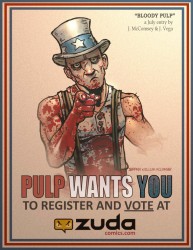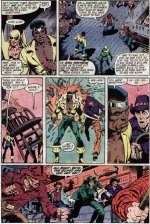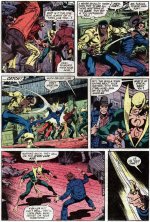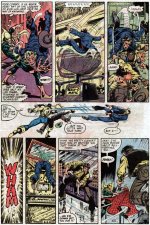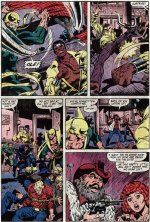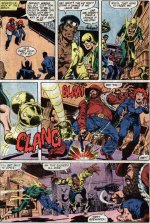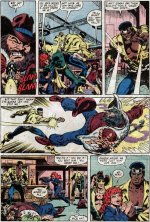Due to reviewing the Lone Wolf & Cub books once a week, I’ve spent a lot of time over the past couple of months thinking about justice and revenge. The reasoning behind revenge, the stresses it puts on someone, the sacrifices necessary to pursue revenge, and even, occasionally, my own personal feelings about it. It’s a little draining, to be honest, but fascinating at the same time.
Garth Ennis and Peter Snejberg’s Battlefields: Dear Billy, published by Dynamite Entertainment, takes the idea of justice and revenge head-on, but not exactly in the way I expected. Most creators, when writing a story about revenge, tends to take the obvious route. Something horrible happens, usually in graphic detail, someone makes a promise, and then a whole lot of people die. You’ve seen it with Ultimate Hawkeye, whose entire family was murdered. Ogami Itto is stacking the bodies up like cordwood. Daredevil’s gone on multiple revenge quests. Omar from The Wire spent the bulk of the fifth season of the show killing men who wronged him.
Ennis and Snejberg present an entirely different scenario. During World War II, on the way to Java, Carrie Sutton, and several other British women, were captured, raped, machineguned, and left for the dead by Japanese soldiers. Carrie was the only survivor.
After her convalescence, Carrie is discharged and becomes a nurse for the British in the Eastern Theater. She meets a man, the Billy of the title, and they fall in love. Their romance allows both of them to escape from the war, both mentally and physically, as they were both brutalized by the Japanese. Billy had been caught after landing his plane, and was bayonetted, though Carrie pretends not to know that. She keeps Billy in the dark about her past, as well. Billy likes the idea of portraying the war as no big deal to his little lady, and she enjoys indulging him in that fantasy. However, it isn’t enough. When a Japanese prisoner of war is brought into Carrie’s hospital, she smothers him with a pillow.
Carrie and Billy’s relationship disintegrates when he says the wrong thing to her. After a night out drinking with friends, they get into an argument about what’s going to happen after the war. Carrie asks, “If the Japs are to be groomed as allies, what the hell are we supposed to do about them?” Billy replies, “Now we learn to love them, Carrie.” And Carrie cannot take that, and so their relationship, and the book, ends.
Carrie went through a harrowing experience and had no outlet for those emotions. There was no way she could actually have justice or closure for her suffering. There would be no trial, no execution, no recompense. So, she killed men. It didn’t make her feel better, but it did do something to make her feel less bad, if only for a moment. The thought of learning to love the people that had traumatized her was too much.
I think the fundamental question at the heart of this book is “What is forgivable?” Being raped and near-murdered left a hole in her heart, and it was an injury that she never truly recovered from, despite finding solace in Billy’s arms. The only thing she wants out of the Japanese, the only thing that makes sense to her, is revenge. After they’ve surrendered, she feels that the British and American should twist the knife and “make them pay.”
Obviously, Carrie murdering the defenseless men is a crime. It’s an act of evil. At the same time, I feel like I understand where she’s coming from. After being hurt, the only thing you want, the only thing you dream of, is hurting someone back. That’s where messy break-ups, painful divorces, alienations, and falling outs come from. It’s the “get-back.”
So while reading, I condemned Carrie with the rational side of my brain and empathized with the other side. It forced me to look at myself and try to figure out how I would react if put into a situation where revenge was easy. And I found that I don’t have an answer. Carrie’s actions are inexcusable, but she was hit very hard by the war. Where Billy could be content with victory, she could not. No act could ever salve her wounds. I’m not saying it’s right, but I understand.
Ennis throws the idea of suffering in silence, British valor, and stiff upper lips directly under the bus. Carrie never gets to discuss her ordeal with anyone, choosing instead to keep it in herself, and it festers and rots inside her. Billy can talk about his injuries with other military men and gain some semblance of comfort, because that’s what men get to do. This may be the key difference between Carrie and Billy’s approach to the war. Carrie is forced to keep it inside, while Billy gets at least a moment to air it out.
Dear Billy is one of my favorite Ennis works, in part because of the ambiguity it spawned in my thoughts. There are no easy answers to be found here. No comforting condemnation of any act. Ennis leaves it up to the reader to decide the morality of Carrie’s actions, and how that applies to us as human beings. This is definitely one of the most melancholy things that he’s written.
Battlefields: Dear Billy is part of a three part cycle. Night Witches
is part of a three part cycle. Night Witches and The Tankies
and The Tankies round out the trilogy, which will be collected into a Battlefields
round out the trilogy, which will be collected into a Battlefields hardcover later this year for thirty bucks. I’m not sure why Amazon lists Dear Billy as not released, as my own copy and Dynamite’s site suggests otherwise. It’s cheap, just thirteen bucks, and worth your time.
hardcover later this year for thirty bucks. I’m not sure why Amazon lists Dear Billy as not released, as my own copy and Dynamite’s site suggests otherwise. It’s cheap, just thirteen bucks, and worth your time.

